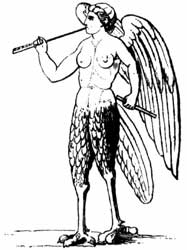Harpy
That is, "the swift robbers," are, in the Homeric poems, nothing but personified storm winds.1 Homer mentions only one by name, viz. Podarge, who was married to Zephyrus, and gave birth to the two horses of Achilles — Xanthus and Balius.2 When a person suddenly disappeared from the earth, it was said that he had been carried off by the Harpies;3 thus, they carried off the daughters of king Pandareus, and gave them as servants to the Erinyes.4

According to Hesiod,5 the Harpies were the daughters of Thaumas by the Oceanid Electra, fair-locked and winged maidens, who surpassed winds and birds in the rapidity of their flight. Their names in Hesiod are Aello and Ocypete.6 But even as early as the time of Aeschylus,7 they are described as ugly creatures with wings, and later writers carry their notions of the Harpies so far as to represent them as most disgusting monsters. They were sent by the gods as a punishment to harass the blind Phineus, and whenever a meal was placed before him, they darted down from the air and carried it off; later writers add, that they either devoured the food themselves, or that they dirtied it by dropping upon it some stinking substance, so as to render it unfit to be eaten. They are further described in these later accounts as birds with the heads of maidens, with long claws on their hands, and with faces pale with hunger.8
The traditions about their parentage likewise differ in the different traditions, for some called them the daughters of Pontus (or Poseidon) and Terra (Gaea),9 of Typhon,10 or even of Phineus.11 Their number is either two, as in Hesiod and Apollodorus, or three; but their names are not the same in all writers, and, besides those already mentioned, we find Aellopus, Nicothoe, Ocythoe, Ocypode, Celaeno, Acholoe.12 Their place of abode is either the islands called Strophades,13 a place at the entrance of Orcus,14 or a cave in Crete.15

The most celebrated story in which the Harpies play a part is that of Phineus, at whose residence the Argonauts arrived while he was plagued by the monsters. He promised to instruct them respecting the course they had to take, if they would deliver him from the Harpies. When the food for Phineus was laid out on a table, the Harpies immediately came, and were attacked by the Boreades, who were among the Argonauts, and provided with wings. According to an ancient oracle, the Harpies were to perish by the hands of the Boreades, but the latter were to die if they could not overtake the Harpies. The latter fled, but one fell into the river Tigris, which was hence called Harpys, and the other reached the Echinades, and as she never returned, the islands were called Strophades. But being worn out with fatigue, she fell down simultaneously with her pursuer; and, as they promised no further to molest Phineus, the two Harpies were not deprived of their lives.16 According to others, the Boreades were on the point of killing the Harpies, when Iris or Hermes appeared, and commanded the conquerors to set them free, or both the Harpies as well as the Boreades died.17
❧
The name is derived from the Greek verb harpazo, "to seize."
Iconography
The best-known representations of the Harpies are the reliefs of the so-called Harpies Tomb (archaic, ca. 480-470 BCE), an Ionic cenotaph at Xanthos: it is a quadrangular pillar, decorated on four sides with reliefs. A procession of figures bring sacrifices to the dead and on the corners creatures are depicted with the bodies of women but with the wings and tails of birds, who abduct the souls of the deceased. A famous Harpy monument from Lycia represents the Harpies in the act of carrying off the daughters of Pandareus.
References
Notes
- Odyssey xx, 66, 77.
- Iliad xvi, 149 ff.
- Odyssey i, 241, xiv, 371.
- Odyssey xx, 78.
- Theogony, 267 ff.
- Comp. Pseudo-Apollodorus. The Library i, 2.6.
- Eumenides, 50.
- Virgil. Aeneid iii, 216 ff.; Tzetzes on Lycophron, 653; Ovid. Metamorphoses vii, 4; Fasti vi, 132; Hyginus. Fabulae, 14.
- Servius on Virgil's Aeneid iii, 241.
- C. Valerius Flaccus. Argonautica iv, 428, 516.
- Tzetzes on Lycophron, 166; Chiliades i, 220; Palaephatus, 23.3.
- Pseudo-Apollodorus. The Library i, 9, 21; Servius on Virgil's Aeneid iii, 209; Hyginus. Fabulae: Preface, p. 15, Fabulae, 14.
- Virgil. Aeneid iii, 210.
- vi, 289.
- Apollonius Rhodius. Argonautica ii, 298.
- Pseudo-Apollodorus. The Library i, 9.21.
- Scholiast on Apollonius Rhodius, i, 286, 297; Tzetzes. Chiliades i, 217.
Sources
- Aken, Dr. A.R.A. van. (1961). Elseviers Mythologische Encyclopedie. Amsterdam: Elsevier.
- Smith, William. (1870). Dictionary of Greek and Roman Biography and Mythology. London: Taylor, Walton, and Maberly.
This article incorporates text from Dictionary of Greek and Roman Biography and Mythology (1870) by William Smith, which is in the public domain.